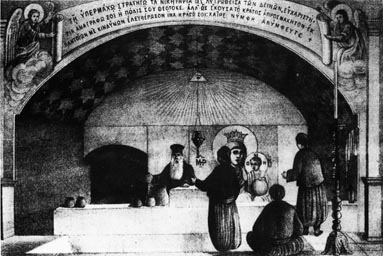The Miracle of the Virgin Mary at the Church of Blachernae
Constantinople in the Year 911 AD
A Brief History of the Miraculous Apparition (1)
Constantinople in the Year 911 AD
A Brief History of the Miraculous Apparition (1)
In the year 911 AD, Constantinople was under military threat and the people were praying for God's help in the Blachernae Church in the suburb of the city. It was in this church that the omophor or veil of the Virgin Mary was reserved as a most precious relic.
The church was crowded for an all-night vigil. Andrew, the future Saint known as a fool-for-Christ, was there, along with his disciple Epiphanius. At about four in the morning, Andrew and Epiphanius had a vision of the Virgin Mary: She entered through the church doors, escorted by St. John the Forerunner and St. John the Theologian and preceded by a host of angels.
She stopped at the ambo (the great stair-cased pulpit in the center of the church) and knelt there, praying fervently and with tears. She then entered the altar and prayed again and finally removed Her veil and held it out over the faithful as She ascended from them.
They concluded from Her presence that Her intercession would be the protection to the faithful in this hour of trial. And so it happened that the feared military menace was averted.
This Miraculous Manifestation and happy consequences are celebrated by the Easter Catholic Church on October 1st.
A Brief History of the Church (2)
The best known and most celebrated shrine of the Holy Virgin in Constantinople was the church of Panagia of Blachernae. The history of the shrine, the fame of which had spread throughout the Christian world, extends over the entire Byzantine era, and the great events associated with it are linked with the history of the City.
The first church at the site of the sacred spring was built and decorated by the Augusta Pulcheria between 450-453 (the year of her death) and her husband, the Emperor Marcian (450-457). The church was completed and embellished further by the Emperor Leo I (457-474), who added the Hagiasma (fountain of holy water) and the Hagion Lousma (sacred bath). Leo I also built the parecclesion of the Hagia Soros to house the holy mantle and robe of the Virgin that had been brought from Palestine to Constantinople in 473.
At times, Emperors showed their personal interest for the church by making donations and adding new constructions and decorations.... A measure of the importance of the shrine is found in Emperor Heraclius's Neara, which appoints a total of 74 persons to the service of the church: 12 presbyters, 18 deacons, 6 deaconesses, 8 sub deacons, 20 readers, 4 chanters and 6 door keepers .
The role played by the Panagia of Blachernae during the Iconoclast crisis, particularly in the reign of Constantine V, should be stressed. Like the Hagia Sophia, this church was a center of Orthodox worship where every Friday an all-night vigil was dedicated to the miracle-working icon of the Virgin. Because of this, the whole iconographic program of the church was destroyed by the iconoclasts.
In 1070 a fire destroyed the church, which was rebuilt by the Emperors Romanus IV Diogenes (1067-1078) and Michael VII Ducas (1071-1078). The entire complex of buildings was ruined in 1434, shortly before the Conquest, when "some young noblemen wishing to catch nestlings" (G. Phrantzes) climbed on the roof and inadvertently started a fire.
After the destructive fire of 1434 and the Fall of Constantinople, nothing remained from the once rich and famous shrine except for the site of the Sacred Spring. The place passed into Ottoman hands until 1867, when it was purchased by the Guild of Greek Orthodox Furriers, who built a small church containing the hagiasma. As time went by, the Ecumenical Patriarchate made certain additions and the ancient sacred enclosure was given the aspect it has today.
The physical address of the chapel containing the Hagiasma, as written down by the driver who took
Miguel de Portugal to such Blessed place is as follows: Ayuansaray Meryem Ana Kilisesi,
Ayuansaray, Istanbul

Panagia of Blachernae, The Hagiasma. Drawing by D. Galanakis for A. G.
Papasatis's book Byzantine Studies (1877) p. 390-391.
NOTES
(1) A Daily Calendar of Saints by Lawrence R. Farley, ISBN 1-880971-24-0
Online since 1998
Introduction for First Visit
Frequently Asked Questions
Home Page English Español Portugues
Search Page Index of Documents
Disclaimer About Us Contact
Back Up Home Page (Mirror Site)
Home Page English Español Portugues
Search Page Index of Documents
Disclaimer About Us Contact
Back Up Home Page (Mirror Site)